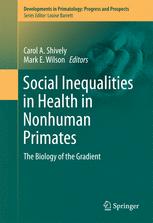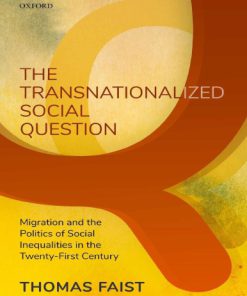Social Inequalities in Health in Nonhuman Primates The Biology of the Gradient 1st Edition by Carol Shively 3319308722 9783319308722
$50.00 Original price was: $50.00.$25.00Current price is: $25.00.
Social Inequalities in Health in Nonhuman Primates The Biology of the Gradient 1st Edition by Carol A. Shively – Ebook PDF Instant Download/DeliveryISBN: 3319308722, 9783319308722
Full download Social Inequalities in Health in Nonhuman Primates The Biology of the Gradient 1st Edition after payment.

Product details:
ISBN-10 : 3319308722
ISBN-13 : 9783319308722
Author: Carol A. Shively
This book provides a comprehensive look at nonhuman primate social inequalities as models for health differences associated with socioeconomic status in humans. The benefit of the socially-housed monkey model is that it provides the complexity of hierarchical structure and rank affiliation, i.e. both negative and positive aspects of social status. At the same time, nonhuman primates are more amenable to controlled experiments and more invasive studies that can be used in human beings to examine the effects of low status on brain development, neuroendocrine function, immunity, and eating behavior. Because all of these biological and behavioral substrates form the underpinnings of human illness, and are likely shared among primates, the nonhuman primate model can significantly advance our understanding of the best interventions in humans.
Social Inequalities in Health in Nonhuman Primates The Biology of the Gradient 1st Table of contents:
1 Relevance of Nonhuman Primate Translational Research to Understanding Social Inequalities in Healt
References
2 An Introduction to the Female Macaque Model of Social Subordination Stress
1 Rodent Models of Stressor Exposure
2 Macaque Social Subordination Model
Acknowledgements
References
3 Effects of Social Subordination on Macaque Neurobehavioral Outcomes: Focus on Neurodevelopment
1 Introduction
2 Social Stress and Development
3 Macaque Model of Chronic Social Subordination Stress
4 Social Subordination, Stress, and the Limbic-Hypothalamic-Pituitary-Adrenal (LHPA) Axis
5 Effects of Social Subordination Stress on Neuromodulators and Gonadal Hormones
6 Effects of Social Subordination Stress on Brain Structure and Function in Adult NHPs
7 Effects of Social Subordination Stress on Rhesus Macaques: Focus on Development
8 Conclusions and Future Directions
References
4 The Effects of Social Experience on the Stress System and Immune Function in Nonhuman Primates
1 Introduction
2 The Stress Response
2.1 Definitions of Stress
2.2 Components of the Stress System
2.2.1 Central Stress System Components
2.2.2 Peripheral Stress System Components
2.3 ACTH and SNS Actions on the Adrenal
2.4 Diurnal Rhythms and Negative Feedback on the HPA Axis
2.5 HPA–Immune Interactions
2.6 SNS–Immune Interactions
2.7 Chronic Stress and Allostatic Load
3 Social Stress Paradigms in Nonhuman Primate Research
3.1 Stress of Social Status
3.1.1 Effects of Social Status on HPA Axis
3.1.2 Effects of Social Subordination on SNS/Immune Function
3.2 Social Instability Stress
3.2.1 Effects of Social Instability on HPA Function
3.2.2 Effects of Social Instability on SNS/Immune Parameters
4 Future Directions
References
5 The Influence of Social Environment on Morbidity, Mortality, and Reproductive Success in Free-Rang
1 Introduction to the Non-human Primate Model of Social Inequality
2 Cercopithecine Social Structure
3 Social-Environmental Effects on Physiological Stress and Morbidity
3.1 Social Status
3.1.1 Glucocorticoids
3.1.2 Immune Function
3.2 Other Social-Environmental Factors
3.3 Conclusions
4 The Influence of Social Environment on Mortality
4.1 Social Status
4.1.1 Adults
4.1.2 Juveniles
4.1.3 Environmental Instability
4.2 Other Social-Environmental Factors
4.3 Conclusions
5 The Influence of Social Environment on Reproductive Success
5.1 Social Status
5.1.1 Reproductive Life span
5.1.2 Birthrates
5.1.3 Infant Mortality
5.2 Male Reproductive Success
5.3 Other Social-Environmental Factors
5.4 Conclusions
6 Final Conclusions
References
6 Social Status and the Non-human Primate Brain
1 Introduction
2 Animal Models of Social Status
2.1 Social Defeat
2.2 Visible Burrow System
2.3 Naked Mole Rat
2.4 Non-human Primates
3 Neurobiology of Social Status in Primates
3.1 Neurodevelopment
3.2 Social Network Size and Neural Circuits
3.3 Neurogenesis
3.4 Monoaminergic Neurotransmission
3.5 Stress Hormone Mediation of Status Differences in Neurobiology
4 Discussion
References
7 Emotional Eating in Socially Subordinate Female Rhesus Monkeys
1 Introduction
1.1 Social Subordination in Female Rhesus Monkeys Is a Potent Psychosocial Stressor
2 Social Subordination Results in Emotional Feeding in a Complex Dietary Environment
3 What Drives Emotional Eating in Subordinate Females?
4 The Role of Corticotropin-Releasing Hormone in Sustaining Emotional Feeding
5 Summary and Conclusion
Acknowledgments
References
8 Dietary Modification of Physiological Responses to Chronic Psychosocial Stress: Implications for t
1 Introduction
2 Physiological Responses to Chronic Stress that Promote Food Consumption and Fat Deposition
2.1 Hypothalamic–Pituitary–Adrenal (HPA) Response to Stress
2.2 Downstream Effects of Autonomic Responses to Stress
3 Dietary Modification of Physiological Responses to Stress
3.1 Diet Composition and Obesity
3.2 Effects of Diet Composition on HPA Responses to Stress
3.3 Effects of Diet Composition on Cardiovascular Responses to Stress
3.4 Effects of Dietary Fat on Dopamine Neurotransmission in Reward Circuitry
4 Implications for the Obesity Epidemic
People also search for Social Inequalities in Health in Nonhuman Primates The Biology of the Gradient 1st:
non human primates in research
nonhuman primate welfare
social inequalities in health
social inequities in healthcare
in nonhuman primates grooming relationships serve
Tags: Social Inequalities, Health, Nonhuman Primates, The Biology, the Gradient, Carol Shively
You may also like…
Politics & Philosophy
Politics & Philosophy - Social Sciences
Arts - Film
Infectious Inequalities Epidemics Trust and Social Vulnerabilities in Cinema 1st Edition Han
Biology and other natural sciences
Politics & Philosophy












